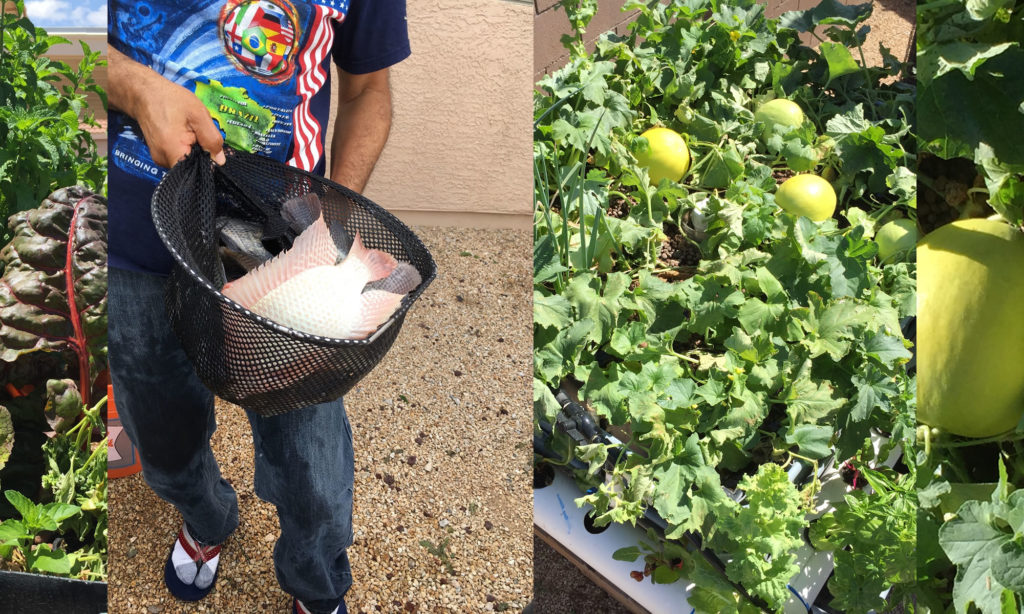AquaBioPonics Systems
More Fish-Vegetables, Less Space
AquaBioPonics Systems – Globally is estimated that 3.1 billion people today rely on fish for food. Currently, aquaculture supplies more than 50 percent of all seafood produced for human consumption—and that percentage will continue to rise (1). Over the past 50 years, annual global consumption of seafood products per capita has more than doubled, from almost 10 kg in 1960 to over 20 kg in 2014 (1)
Aquaculture both marine and freshwater have helped improve nutrition and food security in many parts of the world and it has recently superseded wild-capture fisheries as the main source of seafood for human consumption (2). While being is one of the most intelligent ways to produce protein, fish farming relies on abundant water supply, space and plenty of animal food to make the fish grow. Escalated demand for seafood and the consequent pressure on over-fishing has fueled the growth of fish farms.
In addition, 20% of the wild catch is used to make feed for farmed fish and 75% of all fish oil produced is currently fed to farmed fish. Aquaculture requires the harvest of approximately 300 billion small pelagic ( being neither close to the bottom nor near the shore) fish like anchovies to be used as feed components for farmed species like tilapia, salmon, and shrimp. Consequently, there is an urgent cry to improve the efficiency of resources used to produce fish farmed proteins. (3)
By the other hand, The United Nations Food and Agriculture Organization estimates that about 815 million people of the 7.6 billion people in the world, or one in ten, were suffering from chronic undernourishment in 2016. (Almost all the hungry people, live in developing countries.) (4)
Aiming to give our contribution to undertake these two realities: the need for better resources-optimization used by aquafarmers and almost one billion people going to bed every night without food to eat, AquaBioPonics and following AquaBioPonics Bioflocs Systems (ABP and ABPB) were developed.
ABP, as a closed re-circulation system had its basic biotech strategy to produce high quality organic food in less space in a maximized environment where fish wastes in the form of ammonia nitrogen, nitrite and nitrate could be removed (oxidized) and used by plants to produce vegetable proteins in a complete circular economy.
On other words, to develop a zero-waste method where the well-known two steps chemotrophic autotroph nitrification process (5) could thrill and proliferate aboundingly. This process until recently was found to be produced mainly by the “Nitrosomonas” genus (AOB – ammonia-oxidizing bacteria – according to the equation: NH3 + O2 –> NO2 – + 3H+ + 2e-) and “Nitrobacter” genus (NOB – nitrite-oxidizing bacteria – according to the equation: NO2 – + H2O –> NO3 – + 2H+ +2e- ). (6)
However, well recently it was discovered that another group called complete ammonia oxidation bacteria called – comammox – from Nitrospira genus are actually the predominant microbes to perform aerobic ammonia-nitrite-nitrate oxidation in waste treatment plants and, most remarkable, these novel microbes do just in one step. (7) We will discuss this subject in a future article.
Less Water and Less Space Challenges
At this stage after having implemented many ABP Systems in many parts of the world, we realized that ABP was dealing just with the issue of less space. Less water and less feeding were still big constraints to AquaBioPonics Systems.
Thus, we decided to lean-agile innovate by integrating Bioflocs Technology to ABPs to reach a high level of resources-efficiency in everything we were doing. This is the subject of the next article:
AquaBioPonics Bioflocs Systems! More Fish, Less Space, Less Water, Less Feeding
Citations:
(1) FAO (Food and Agriculture Organization of the United Nations). 2016. The State of World Fisheries and Aquaculture 2016. Contributing to food security and nutrition for all. FAO, Rome. 239 pp
(2) Guillen, J., Natale, F., Carvalho, N. et al. Ambio (2019) 48: 111. https://doi.org/10.1007/s13280-018-1060-9
(3) Chamberlain, A. 2011. Fishmeal and fish oil: the facts, figures, trends, and IFFO’s responsible supply standard. London, Marine Ingredients Organisation. (also available at www.iffo.net/ system/files/FMFOF2011_0.pdf
(4) FAO (Food and Agriculture Organization of the United Nations). 2016. The State of Food Security and Nutrition in the World 2019. FAO, Rome. 200 pp
(5) Warington R. 1890. Note on the isolation of the nitrifying organism. Chem News 51: 135–136, No. 1582 March 21.
(6) U.S. Environmental Protection Agency. 2002a. Nitrification. Https://www.epa.gov/sites/production/files/2015-09/documents/nitrification_1.pdf. August 15, 2002.
(7) van Kessel MA, Speth DR, Albertsen M, et al. 2015. Complete nitrification by a single microorganism. Nature. 2015;528(7583):555–559. doi:10.1038/nature16459



